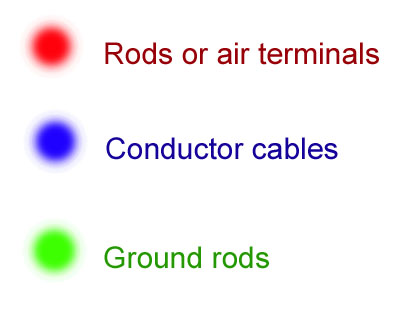During the kite experiment, Benjamin Franklin put an iron stalk on the kite. As he wanted to prove the similarities between lightning and electricity, that was an exellent reasoning.
Indeed, a law regarding electricity was discovered after Franklin’s life-time. It tells us the smaller an object is, the stronger its electric field is near it. The law involved is Gauss’ law.

Where E is the value of the electric field in a point near the sphere,
1/(4πε) is a constant ( also called k),
Q the total electric charge of the sphere,
and r the radius from the source to the point.

E(S1)= k*Q*(1/R²)= (k*Q)/(2r)²= (k*Q)/r² * ¼
= ¼ E(S2)
E(S2)= k*Q*(1/r²)= (k*Q)/r²= (k*Q)/r²= 4 E(S1)
E is inversely proportional to r squared
That proves that with a radius twice smaller, S2 owns an electric field 4 times stronger near it.
If we apply that principle to an infinitely small object, its electric field will be infinitely strong near it. And if we identify a point as a small object, its electric field is strongly worth. It is an important factor that allows the ionization of the air particles wich determines the path of the lightning.







 Fire– Fire can start anywhere the exposed lightning channel contacts, penetrates or comes near flammable material (wood, paper, gas pipes, etc) in a building – including structural lumber or insulation inside walls and roofs. When lightning follows electrical wiring, it will often overheat or even vaporize the wires, creating a fire hazard anywhere along affected circuits.
Fire– Fire can start anywhere the exposed lightning channel contacts, penetrates or comes near flammable material (wood, paper, gas pipes, etc) in a building – including structural lumber or insulation inside walls and roofs. When lightning follows electrical wiring, it will often overheat or even vaporize the wires, creating a fire hazard anywhere along affected circuits. Side flashes – Side flashes can jump across rooms, possibly injuring anyone who happens to be in the way. They can also ignite materials such as a gasoline in a garage.
Side flashes – Side flashes can jump across rooms, possibly injuring anyone who happens to be in the way. They can also ignite materials such as a gasoline in a garage. Damage to building materials – The explosive shock wave created by a lightning discharge can blow out sections of walls, fragment concrete and plaster, and shatter nearby glass.
Damage to building materials – The explosive shock wave created by a lightning discharge can blow out sections of walls, fragment concrete and plaster, and shatter nearby glass. Damage to electrical appliances – Televisions, microwaves, phones, washers, lamps and just about anything plugged into an affected circuit may be damaged beyond repair. Electronic devices and computers are especially vulnerable.
Damage to electrical appliances – Televisions, microwaves, phones, washers, lamps and just about anything plugged into an affected circuit may be damaged beyond repair. Electronic devices and computers are especially vulnerable.
 Don’t attract lightning
Don’t attract lightning Lightning protection systems (including placement of rods, cables, and groundings) are designed for individual structures. They should only be installed by qualified contractors.
Lightning protection systems (including placement of rods, cables, and groundings) are designed for individual structures. They should only be installed by qualified contractors. 
